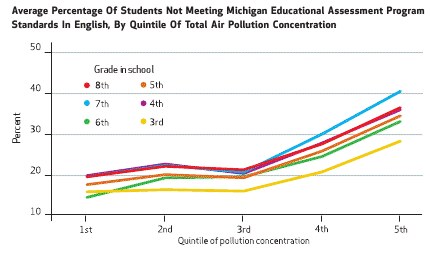Have you ever thought as you were driving to school each morning, you were harming your education at the same time? Well, it does. Did you ever wonder if your dad was endangering your academic success as he took the expressway to work? Well, he is.
Kerry Joy Ard, a graduate student majoring in sociology and environmental policy, teamed up with Paul Mohai, a professor at the School of Natural Resources and Environment, Byoung-Suk Kweon, a research investigator at the Institute for Social Research and Sangyun Lee, a postdoctoral research fellow, all at the University of Michigan.
The project they undertook was regarding health affairs in Michigan. Specifically, how pollution affects children’s learning and development. 
Ard, the researcher of the project, stated that “a lot of analysts don’t really [look at] how things play out spatially.” The map the team created a unique visual resource that shows how the pollution in Michigan compares to student performance.
For the project, academic success or failure was measured using MEAP scores. Ard explained that, in general, “the more polluted [the] area, the worse the MEAP scores.”
The data they collected included twelve chemicals (“diisocyanates, manganese, sulfuric acid, nickel, chlorine, chromium, trimethylbenzene, hydrochloric acid, molybdenum trioxide, lead, cobalt and glycol ethers”) made up 95% of the estimated pollution found in industrial sources in Michigan found around schools. They got their data from the EPA, or the U.S. Environmental Protection Agency, from various toxic release facilities located around the state.
The areas measured for pollution were, “a little bigger than the size of the Diag,” explained Ard.
Many of the aforementioned chemicals have the potential to damage respiratory organs, eyes, skin, and intestines, as well as cause cancer and contact dermatitis.
“We figured out the socioeconomic characteristics of the schools by looking at how many kids in the area were given free lunches… and the student-to-teacher ratio,” states Ard.
“Air pollution around schools is linked to poorer student health and academic performance,” opens their document. Within the most polluted decile, 62.2 percent of all students across the state were enrolled in the free lunch program. Economically disadvantaged students were more likely to live in the most polluted areas of Michigan.
One of the points the authors make is that because of the worsening pollution in areas where students live, “…attendance rates were lower in schools with greater concentration of pollution around them.” This potentially indicates that higher pollution worsens health as a whole, causing student’s attendance to suffer.
The group continued by stating that attendance rates did not vary appreciably for schools in the first three quintiles, “we found statistically significant decreases in these rates for schools in the fourth and fifth quintiles.” They found that this was true even after comparing it to various locational and economic school variables.
When looking at the state of Michigan as a whole, “We found that 62.5 percent of [the schools] were located in grid cells in the ninth and tenth deciles.”
“Schools tend to be located in the most polluted area…” said Ard, “…which is crazy.” The authors give various steps to prevent or decrease how drastically pollution affects students’ academics. These include analyzing potential school sites for pollutants including the soil, water and air. Another prevention method is to require school sites to be a certain distance from pollution sources, adopt policies to reduce pollution exposure, and finally, to ensure cooperation between agencies to ensure a safer school environment.
Courtney Kiley, a science teacher at Community High School stated that the findings of the study coincided with goals that the Ecology club set previously. The Ecology club hopes reduce pollution near school campuses. Kiley added that they “just want to educate people about it and [how to] reduce it.”
The CHS ecology club (led by Kiley) wants to teach people, especially targeting other schools ways to reduce emissions. Some examples include such things as carpooling, taking the bus and biking in regards to getting to and from school.
Most of all though, is that the CHS ecology club wants to teach the younger generations in particular of the “social impacts of [pollution].”
















